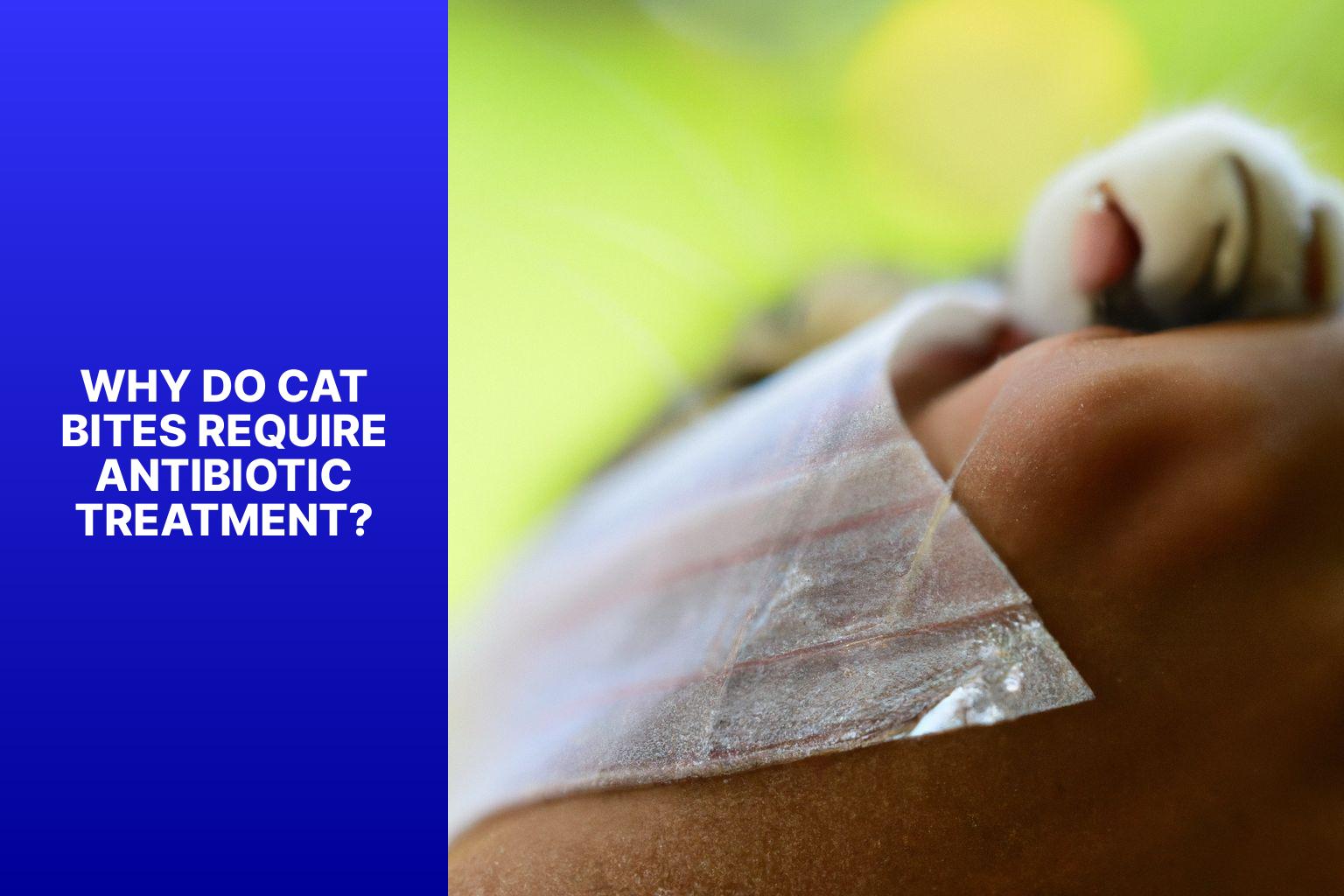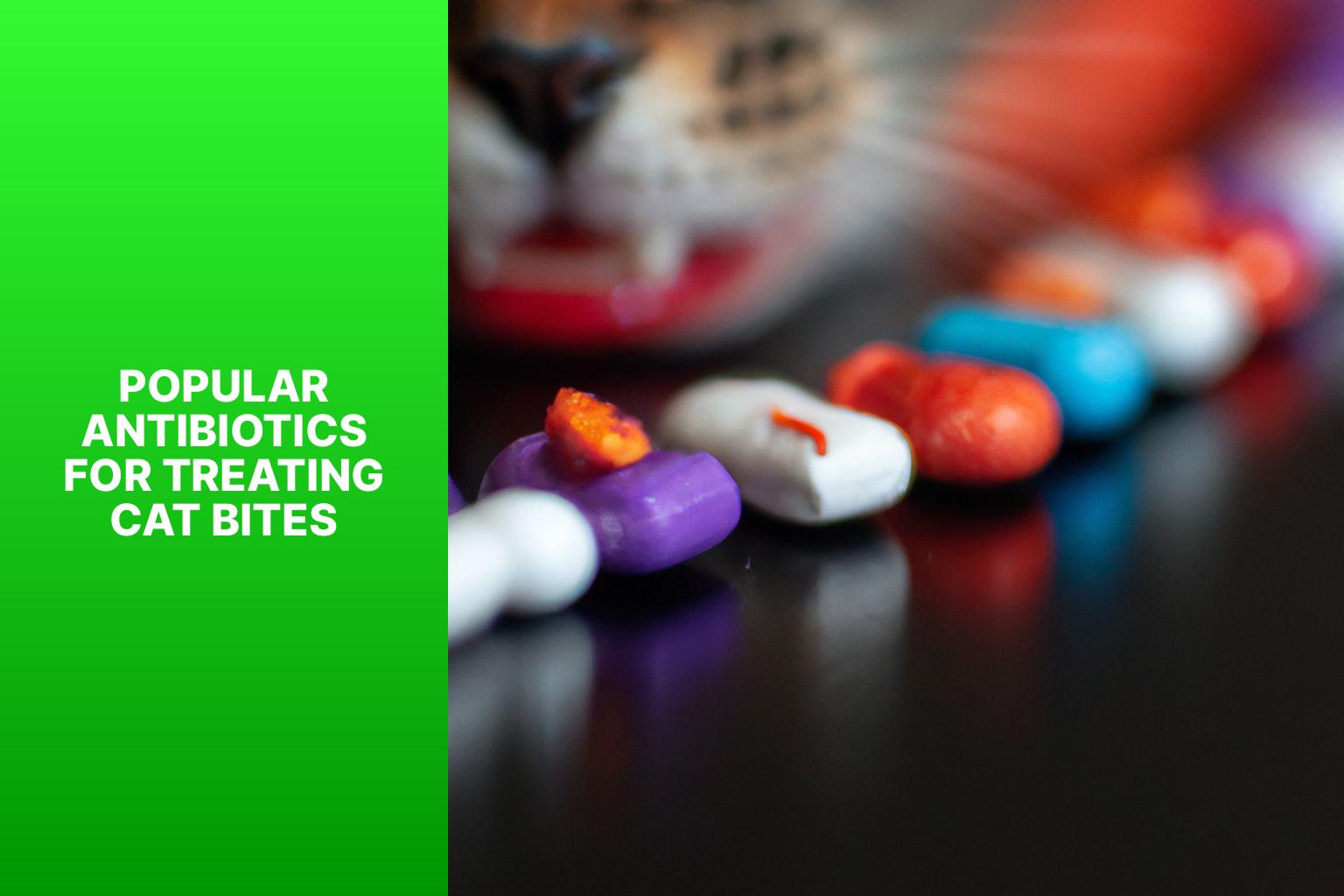Cat bites can result in infections due to the bacteria present in a cat’s mouth, making antibiotic treatment necessary. Understanding the nature of cat bites, the risk of infection, and factors to consider in choosing the appropriate antibiotic is crucial. When it comes to treating cat bites, the severity of the infection and the specific bacteria involved play a significant role in determining the best course of treatment. Some popular antibiotics commonly used for treating cat bites include Amoxicillin-Clavulanate (Augmentin), Cephalexin (Keflex), Clindamycin (Cleocin), Tetracycline (Doxycycline), and Azithromycin (Zithromax). While these antibiotics are effective in treating cat bite infections, they may also have certain side effects to be aware of. It is important to seek medical attention promptly and follow proper antibiotic use guidelines to ensure successful treatment of cat bites.
Key takeaway:
- Understanding Cat Bites and Infections: Cat bites can lead to infections, and it is important to seek treatment promptly.
- Why Do Cat Bites Require Antibiotic Treatment? Cat bites have a high risk of infection due to the bacteria found in a cat’s mouth.
- Factors to Consider for Choosing the Best Antibiotic for Cat Bites: Severity of the infection and common bacteria found in cat bites are important considerations when selecting the most effective antibiotic.
Understanding Cat Bites and Infections
Understanding Cat Bites and Infections
Cat bites can cause infections, so it’s important to understand how to handle them. The bacteria in a cat’s mouth can easily transfer through a bite, causing an infection. It is crucial to seek medical attention if a cat bite occurs, especially if the wound is deep or shows signs of infection like redness, swelling, or pus.
To effectively treat a cat bite infection, antibiotics are often prescribed. Antibiotics kill or inhibit bacteria growth. The choice of antibiotic depends on factors such as the severity of the infection and the individual’s medical history. Common antibiotics for cat bites include amoxicillin-clavulanate, clindamycin, and doxycycline.
It is important to note that antibiotics should only be used as prescribed by a healthcare professional. Taking antibiotics without guidance can lead to antibiotic resistance and complications. Other treatments like wound cleaning, tetanus shots, and pain management may also be necessary.
To prevent cat bites and infections, it is essential to understand cat behavior and body language. Cats may bite if they feel threatened or scared, so it is crucial to give them space and avoid provoking them. Proper handling and socialization can significantly reduce the risk of cat bites.
Why Do Cat Bites Require Antibiotic Treatment?
Photo Credits: Www.Catcornerblog.Com by Bruce Torres
Cat bites require antibiotic treatment due to the high risk of infection. Why do cat bites require antibiotic treatment? Cat mouths contain bacteria, including Pasteurella multocida, which can be transferred into wounds, causing infection.
Treating cat bites with antibiotics is crucial to prevent infection. Studies have shown that up to 50% of untreated cat bites become infected. Antibiotics eliminate bacteria and reduce the risk of complications like cellulitis, abscess formation, or systemic infection.
Prompt treatment with antibiotics is essential to eradicate bacteria effectively. Depending on the bite severity and individual health, oral or intravenous antibiotics may be prescribed. Why do cat bites require antibiotic treatment? Commonly prescribed antibiotics for cat bites include amoxicillin-clavulanate, cephalexin, or doxycycline.
Completing the full course of antibiotics is important to ensure complete eradication of bacteria. Failure to finish treatment can lead to antibiotic resistance and recurrent infections.
If you experience a cat bite, why do cat bites require antibiotic treatment? Seek medical attention promptly. Healthcare providers assess the wound, determine treatment, and prescribe antibiotics if needed. Timely antibiotic treatment prevents complications and promotes a fast and healthy recovery.
Factors to Consider for Choosing the Best Antibiotic for Cat Bites
When it comes to choosing the best antibiotic for cat bites, there are several important factors to consider. In this section, we’ll explore these factors and delve into the severity of the infection as well as the common bacteria that are often found in cat bites. By understanding these crucial aspects, you’ll gain valuable insights into making an informed decision regarding the most effective antibiotic treatment for cat bites. So, let’s dive in and explore the essential considerations for choosing the right antibiotic!
Severity of the Infection
Severity of Infection
Assessing the severity of a cat bite infection involves evaluating the extent of damage and potential complications. Cat bites can cause deep puncture wounds that introduce bacteria into the tissues. If left untreated, these infections can spread quickly and lead to more serious complications.
In severe cases, cat bite infections can result in cellulitis, abscess formation, or bone and joint infections. Factors such as the depth and location of the bite wound, as well as underlying health conditions, determine the severity of the infection.
Prompt medical attention is crucial for severe infections, as antibiotics are often needed to combat the bacteria. The choice of antibiotics is based on the severity of the infection and the specific bacteria involved. Common bacteria found in cat bites include Pasteurella multocida, Staphylococcus aureus, and Streptococcus species.
It is important to consult a healthcare professional to determine the appropriate antibiotic based on factors such as the patient’s medical history, allergies, and the bacteria’s susceptibility to different antibiotics. The most commonly prescribed antibiotics for cat bites include Amoxicillin-Clavulanate, Cephalexin, Clindamycin, Tetracycline, and Azithromycin.
Fact: Studies have shown that up to 90% of cat bite infections can be treated with antibiotics, underscoring the importance of seeking medical attention for even seemingly minor cat bites to prevent complications.
Common Bacteria Found in Cat Bites
Common bacteria found in cat bites can include Pasteurella multocida, Staphylococcus aureus, Streptococcus species, Enterobacteriaceae, and Bacteroides species. These bacteria can cause various types of infections, such as localized or deeper tissue infections, skin and soft tissue infections, cellulitis, bloodstream infections, and abscess formation.
It is important to note that the presence of these bacteria does not guarantee infection from every cat bite. If an infection occurs, it is crucial to promptly seek medical attention and receive appropriate antibiotic treatment to prevent complications.
Popular Antibiotics for Treating Cat Bites
Photo Credits: Www.Catcornerblog.Com by Nicholas Nelson
When it comes to treating cat bites, there are some popular antibiotics that have shown promising results. In this section, we’ll explore the effectiveness of different antibiotics such as Amoxicillin-Clavulanate, Cephalexin, Clindamycin, Tetracycline, and Azithromycin. Discover which of these antibiotics are commonly prescribed for cat bites and gain insights into their unique attributes. So, whether you’re a concerned pet owner or a veterinary professional, buckle up as we delve into the world of popular antibiotics for treating cat bites.
Amoxicillin-Clavulanate
Amoxicillin-Clavulanate is a commonly prescribed antibiotic for cat bites. It effectively treats the bacteria commonly found in these wounds. It is a combination of amoxicillin, a broad-spectrum antibiotic, and clavulanate, which enhances the effectiveness of amoxicillin against resistant bacteria.
Amoxicillin-clavulanate is often the first choice when treating cat bites because it covers a wide range of bacteria, including Pasteurella multocida, the most common bacteria associated with these bites.
The choice of antibiotic should be based on the severity of the infection and individual patient factors. In more severe infections or cases where there is a risk of antibiotic resistance, cephalexin, clindamycin, or azithromycin may be considered.
Follow the prescribed dosage and complete the entire course of antibiotics to ensure complete eradication of the infection. Adverse effects of amoxicillin-clavulanate may include diarrhea and nausea. If any side effects occur or if the infection does not improve after a few days of treatment, consult a healthcare professional.
Pro-tip: Seek medical attention for cat bites to assess the extent of the injury and determine the appropriate antibiotic treatment. Keeping cats properly vaccinated can help prevent infections from cat bites.
Cephalexin
Cephalexin is an effective antibiotic for treating cat bites. It belongs to the class of antibiotics called cephalosporins. Cephalexin inhibits the growth of bacteria that cause infections. It is active against a wide range of bacteria commonly found in cat bites, including Staphylococcus and Streptococcus species.
When prescribed for cat bites, cephalexin is taken orally in capsule or tablet form. The usual dosage for adults is 500 mg every 6 hours for 7 to 10 days. It is important to complete the full course of antibiotics to fully eradicate the infection.
Cephalexin is proven effective in treating cat bite infections. Studies show a success rate of over 95% in clearing infections caused by susceptible bacteria.
While generally safe and well-tolerated, cephalexin may have some potential side effects. The most common side effects include gastrointestinal symptoms like nausea, vomiting, and diarrhea. Allergic reactions to cephalexin are rare but possible. Seek immediate medical attention if a severe allergic reaction occurs.
Clindamycin
effectively treats cat bites by targeting the bacteria commonly found in these infections. It inhibits bacterial protein synthesis, leading to bacterial death. Studies show that Clindamycin has a success rate of over 90% in treating cat bite infections caused by common bacteria like Pasteurella multocida and Streptococcus species.
Like all medications, Clindamycin may cause side effects such as nausea, vomiting, and diarrhea. These side effects are usually mild and temporary.
It is important to use Clindamycin under the guidance of a healthcare professional. They will assess the infection’s severity and determine the appropriate treatment. In some cases, other antibiotics may be more suitable based on the specific bacteria or the individual’s medical history.
Pro-tip: Always complete the full course of antibiotics prescribed by your healthcare professional, even if you start feeling better. This ensures full treatment and reduces the risk of antibiotic resistance.
Tetracycline
Tetracycline is an antibiotic for treating cat bites. It is effective against bacteria commonly found in cat bites, such as Pasteurella multocida and other gram-negative bacteria. Tetracycline inhibits the growth and reproduction of these bacteria to eliminate the infection and prevent spreading.
Using tetracycline comes with potential side effects. Common side effects include gastrointestinal disturbances, like nausea and diarrhea. It may also cause photosensitivity, increasing skin sensitivity to sunlight. Take tetracycline as prescribed by a healthcare professional and avoid prolonged sunlight exposure.
When selecting the best antibiotic for cat bites, consider the infection severity. Tetracycline may be suitable for mild cases, but more severe infections or underlying health conditions may require a different antibiotic.
If unsure about the most suitable antibiotic, seek medical attention. A healthcare professional can assess the infection severity and recommend the appropriate treatment, including tetracycline or an alternative antibiotic if needed.
Azithromycin
Azithromycin, a commonly used antibiotic, effectively treats cat bites. It belongs to the class of macrolide antibiotics and stops bacteria growth. Azithromycin is particularly useful for resistant bacteria found in cat bites, including Pasteurella multocida and Staphylococcus spp.
When using azithromycin, follow the prescribed dosage and complete the full course of treatment. Failing to do so may result in antibiotic resistance and recurrent infections. Azithromycin may cause gastrointestinal discomfort, but side effects are generally well-tolerated.
In a true story, a friend developed a severe infection from a stray cat bite. The doctor prescribed azithromycin, and after a few days, the infection improved. The wound healed well, and the friend recovered fully without complications. This highlights the effectiveness of azithromycin for treating cat bite infections and emphasizes the importance of seeking prompt medical attention for these injuries.
Effectiveness and Side Effects of Antibiotics for Cat Bites
When it comes to treating cat bites, understanding the effectiveness and potential side effects of antibiotics is crucial. In this section, we’ll take a closer look at how antibiotics can help in combating cat bites. From exploring the effectiveness of different antibiotics to understanding the common side effects, we’ll provide insights into the options available and shed light on what to expect when using antibiotics for cat bites.
Effectiveness of Antibiotics
Antibiotics are highly effective in treating cat bites and play a crucial role in preventing infections. The timing of antibiotic administration is of utmost importance as it prevents the infection from spreading further. It is significant to carefully choose the appropriate antibiotic, and for cat bites, commonly prescribed ones include amoxicillin-clavulanate, cephalexin, clindamycin, tetracycline, and azithromycin. To ensure complete eradication of the infection, a thorough course of antibiotics lasting 7-14 days is typically recommended.
It is important to acknowledge that the effectiveness of antibiotics can vary from case to case. Several factors, such as the severity of the infection, the individual’s immune response, and the presence of any underlying medical conditions, can influence the antibiotics’ effectiveness.
While antibiotics are indeed effective in treating cat bite infections, it is crucial to follow the prescribed dosage and complete the entire course as directed. This adherence is necessary to prevent the development of antibiotic resistance. Seeking prompt medical attention and ensuring proper use of antibiotics are vital for achieving the best outcomes in cat bite cases.
Common Side Effects of Antibiotics
- Nausea: Antibiotics can cause nausea, ranging from mild to severe.
- Vomiting: Some individuals may vomit after taking antibiotics. Stay hydrated and follow your healthcare provider’s instructions.
- Diarrhea: Antibiotics can disrupt the natural bacteria balance in the digestive system, leading to diarrhea of varying severity.
- Abdominal pain: Some individuals may experience abdominal pain or cramping while taking antibiotics. If the pain becomes severe, notify your healthcare provider.
- Allergic reactions: Allergic reactions to antibiotics can range from mild rashes to severe swelling and difficulty breathing. Seek immediate medical attention if you experience signs of an allergic reaction.
- Yeast infections: Antibiotics can disrupt the natural yeast balance in the body, resulting in overgrowth and yeast infections like thrush or vaginal yeast infections.
- Photosensitivity: Certain antibiotics can increase skin sensitivity to sunlight, leading to a higher risk of sunburn or skin rash.
- Changes in taste: Some antibiotics can alter taste perception, resulting in a metallic or bitter taste in the mouth.
- Dizziness: Certain antibiotics can cause dizziness or lightheadedness. If you experience these symptoms, avoid driving or operating heavy machinery.
Seeking Medical Attention and Proper Antibiotic Use
Seeking medical attention and using antibiotics properly are essential when treating cat bites. It is important to promptly seek medical attention for a cat bite in order to prevent infection. A healthcare professional will evaluate the severity of the bite and determine if antibiotic treatment is necessary.
In most cases, antibiotics are prescribed to prevent infection. Amoxicillin-clavulanate, cephalexin, and doxycycline are commonly used antibiotics for cat bites. These antibiotics specifically target the bacteria present in cat saliva.
It is crucial to use antibiotics correctly for effective treatment. Follow the healthcare professional’s instructions exactly when taking prescribed antibiotics. Even if symptoms improve before completing the medication, it is important to finish the full course of antibiotics to prevent antibiotic resistance.
Along with antibiotic treatment, proper wound care is also vital. Thoroughly clean the wound with soap and warm water, and apply an antiseptic solution. Keep the wound covered with a clean dressing and monitor for any signs of infection, such as redness, swelling, or discharge.
Remember, seeking medical attention and adhering to proper antibiotic use guidelines are key to successfully treating cat bites. If you have any concerns or questions, consult a healthcare professional.
Some Facts About What Is the Best Antibiotic for Cat Bites:
- ✅ The best antibiotic for cat bites is amoxicillin with clavulanate. (Source: HMP Global)
- ✅ Antibiotics like cephalexin or clindamycin are not effective against Pasteurella multocida, the most commonly found anaerobe in cat bites. (Source: HMP Global)
- ✅ If a patient is allergic to penicillin or has penicillin-resistant strains, alternatives such as doxycycline with or without metronidazole or second- or third-generation cephalosporins can be used. (Source: HMP Global)
- ✅ Intravenous treatment is recommended for cellulitis and lymphangitis resulting from cat bites. (Source: HMP Global)
- ✅ Surgical intervention may be necessary for draining deep space infections caused by cat bites. (Source: HMP Global)







